Mitochondrial Integrity and Function in the Progression of Early Pressure Overload-Induced Left Ventricular Remodeling
- PMID: 28619984
- PMCID: PMC5669187
- DOI: 10.1161/JAHA.117.005869
Mitochondrial Integrity and Function in the Progression of Early Pressure Overload-Induced Left Ventricular Remodeling
Abstract
Background: Following pressure overload, compensatory concentric left ventricular remodeling (CR) variably transitions to eccentric remodeling (ER) and systolic dysfunction. Mechanisms responsible for this transition are incompletely understood. Here we leverage phenotypic variability in pressure overload-induced cardiac remodeling to test the hypothesis that altered mitochondrial homeostasis and calcium handling occur early in the transition from CR to ER, before overt systolic dysfunction.
Methods and results: Sprague Dawley rats were subjected to ascending aortic banding, (n=68) or sham procedure (n=5). At 3 weeks post-ascending aortic banding, all rats showed CR (left ventricular volumes < sham). At 8 weeks post-ascending aortic banding, ejection fraction was increased or preserved but 3 geometric phenotypes were evident despite similar pressure overload severity: persistent CR, mild ER, and moderate ER with left ventricular volumes lower than, similar to, and higher than sham, respectively. Relative to sham, CR and mild ER phenotypes displayed increased phospholamban, S16 phosphorylation, reduced sodium-calcium exchanger expression, and increased mitochondrial biogenesis/content and normal oxidative capacity, whereas moderate ER phenotype displayed decreased p-phospholamban, S16, increased sodium-calcium exchanger expression, similar degree of mitochondrial biogenesis/content, and impaired oxidative capacity with unique activation of mitochondrial autophagy and apoptosis markers (BNIP3 and Bax/Bcl-2).
Conclusions: After pressure overload, mitochondrial biogenesis and function and calcium handling are enhanced in compensatory CR. The transition to mild ER is associated with decrease in mitochondrial biogenesis and content; however, the progression to moderate ER is associated with enhanced mitochondrial autophagy/apoptosis and impaired mitochondrial function and calcium handling, which precede the onset of overt systolic dysfunction.
Keywords: heart failure; hypertrophy; mitochondria; remodeling.
© 2017 The Authors and Mayo Clinic. Published on behalf of the American Heart Association, Inc., by Wiley.
Figures

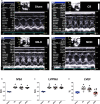
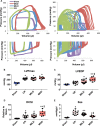
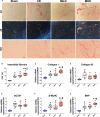


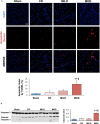
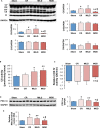
Similar articles
-
Increased passive stiffness promotes diastolic dysfunction despite improved Ca2+ handling during left ventricular concentric hypertrophy.Cardiovasc Res. 2017 Aug 1;113(10):1161-1172. doi: 10.1093/cvr/cvx087. Cardiovasc Res. 2017. PMID: 28472418 Free PMC article.
-
Disruption of actin dynamics regulated by Rho effector mDia1 attenuates pressure overload-induced cardiac hypertrophic responses and exacerbates dysfunction.Cardiovasc Res. 2021 Mar 21;117(4):1103-1117. doi: 10.1093/cvr/cvaa206. Cardiovasc Res. 2021. PMID: 32647865
-
Mitochondrial Reversible Changes Determine Diastolic Function Adaptations During Myocardial (Reverse) Remodeling.Circ Heart Fail. 2020 Nov;13(11):e006170. doi: 10.1161/CIRCHEARTFAILURE.119.006170. Epub 2020 Nov 12. Circ Heart Fail. 2020. PMID: 33176457
-
Myocardial remodeling with aortic stenosis and after aortic valve replacement: mechanisms and future prognostic implications.J Thorac Cardiovasc Surg. 2012 Mar;143(3):656-64. doi: 10.1016/j.jtcvs.2011.04.044. Epub 2011 Jul 16. J Thorac Cardiovasc Surg. 2012. PMID: 21762938 Free PMC article. Review.
-
Mitochondrial pruning by Nix and BNip3: an essential function for cardiac-expressed death factors.J Cardiovasc Transl Res. 2010 Aug;3(4):374-83. doi: 10.1007/s12265-010-9174-x. Epub 2010 Mar 16. J Cardiovasc Transl Res. 2010. PMID: 20559783 Free PMC article. Review.
Cited by
-
Quantitative temporal analysis of protein dynamics in cardiac remodeling.J Mol Cell Cardiol. 2018 Aug;121:163-172. doi: 10.1016/j.yjmcc.2018.07.126. Epub 2018 Jul 19. J Mol Cell Cardiol. 2018. PMID: 30009778 Free PMC article.
-
Left ventricular dysfunction in heart failure with preserved ejection fraction-molecular mechanisms and impact on right ventricular function.Cardiovasc Diagn Ther. 2020 Oct;10(5):1541-1560. doi: 10.21037/cdt-20-477. Cardiovasc Diagn Ther. 2020. PMID: 33224773 Free PMC article. Review.
-
Heart failure after pressure overload in autosomal-dominant desminopathies: Lessons from heterozygous DES-p.R349P knock-in mice.PLoS One. 2020 Mar 3;15(3):e0228913. doi: 10.1371/journal.pone.0228913. eCollection 2020. PLoS One. 2020. PMID: 32126091 Free PMC article.
-
In Silico Analysis of Differential Gene Expression in Three Common Rat Models of Diastolic Dysfunction.Front Cardiovasc Med. 2018 Feb 21;5:11. doi: 10.3389/fcvm.2018.00011. eCollection 2018. Front Cardiovasc Med. 2018. PMID: 29556499 Free PMC article.
-
Structural and Functional Remodeling of Mitochondria in Cardiac Diseases.Int J Mol Sci. 2021 Apr 17;22(8):4167. doi: 10.3390/ijms22084167. Int J Mol Sci. 2021. PMID: 33920673 Free PMC article. Review.
References
-
- McMurray JJ, Petrie MC, Murdoch DR, Davie AP. Clinical epidemiology of heart failure: public and private health burden. Eur Heart J. 1998;19(Suppl P):P9–P16. - PubMed
-
- Nichols M, Townsend N, Scarborough P, Rayner M. Cardiovascular disease in Europe 2014: epidemiological update. Eur Heart J. 2014;35:2950–2959. - PubMed
-
- Williamson JD, Supiano MA, Applegate WB, Berlowitz DR, Campbell RC, Chertow GM, Fine LJ, Haley WE, Hawfield AT, Ix JH, Kitzman DW, Kostis JB, Krousel‐Wood MA, Launer LJ, Oparil S, Rodriguez CJ, Roumie CL, Shorr RI, Sink KM, Wadley VG, Whelton PK, Whittle J, Woolard NF, Wright JT Jr, Pajewski NM. Intensive vs standard blood pressure control and cardiovascular disease outcomes in adults aged >/=75 years: a randomized clinical trial. JAMA. 2016;315:2673–2682. - PMC - PubMed
-
- Thomopoulos C, Parati G, Zanchetti A. Effects of blood pressure‐lowering treatment. 6. Prevention of heart failure and new‐onset heart failure–meta‐analyses of randomized trials. J Hypertens 2016;34:373–384; discussion 384. - PubMed
MeSH terms
Substances
Grants and funding
LinkOut - more resources
Full Text Sources
Other Literature Sources
Medical
Research Materials

